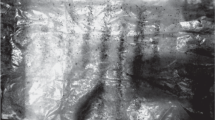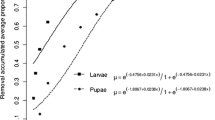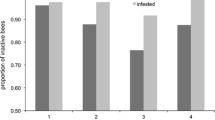Abstract
The behavioral activity of Varroa destructor was observed using transparent cells. Mite oviposition started at 45.0 ± 25.0 h post capping, followed by the next eggs laid at regular 27.3 ± 2.0 h intervals. On the prepupa, mites were found to feed often and there was no preference for a specific segment as a feeding site. During the pupal stage the mite fed less often and almost always at the same point. Varroa showed a preference for defecation in the posterior part of the cell. A significant association was observed between the position of the feeding point in the pupa and the defecation site on the cell wall. Displacement behavior was observed in 71 % of the infested bee larvae and a major change in the free space available for varroa in the cell occurred when the prepupa molted into a pupa.



Similar content being viewed by others
References
Anderson DL, Trueman JWH (2000) Varroa jacobsoni (Acari: Varroidae) is more than one species. Exp Appl Acarol 24:165–189
Bailey L, Ball BV (1991) Honey bee pathology. Academic Press, London
Boot W, Tan NQ, Dien PC, Huan LV, Dung NV, Long LT, Beetsma J (1997) Reproductive success of Varroa jacobsoni in brood of its original host, Apis cerana, in comparison to that of its new host, Apis mellifera (Hymenoptera: Apidae). Bull Entomol Res 87:119–126
Calderón RA, Sommeijer MJ, de Ruijter A, van Veen JW (2003) The reproductive ability of Varroa destructor in worker brood of Africanized and hybrid honey bees in Costa Rica. J Apic Res 42:65–67
Calderón RA, Zamora LG, Van Veen JW, Quesada MV (2007) A comparison of the reproductive ability of Varroa destructor (Mesostigmata: Varroidae) in worker and drone brood of Africanized honey bees (Apis mellifera). Exp Appl Acarol 43:25–32
Calderón RA, Fallas N, Zamora LG, Van Veen JW, Sanchez LA (2009) Behavior of varroa mites in worker brood cells of Africanized honey bees. Exp Appl Acarol 49:329–338
Camazine S (1986) Differential reproduction of the mite, Varroa jacobsoni (Mesostigmata: Varroidae), on Africanized and European honey bees (Hymenoptera: Apidae). Ann Entomol Soc Am 79:801–803
Correa-Marquez MA, Medina L, Martin S, De Jong D (2003) Comparing data on the reproduction of Varroa destructor. Genet Mol Res 2:1–6
De Jong D (1997) Varroa and other parasites of brood. In: Morse R, Flotum K (eds) Honey bee pests, predators, and diseases, 3rd edn. A. I. Root Co, Ohio, pp 280–327
Donzé G, Guerin P (1994) Behavioral attributes and parental care of varroa mites parasiting honey bee brood. Behav Ecol Sociobiol 34:305–319
Donzé G, Guerin P (1997) Time-activity budgets and spacing structure by the different life stages of Varroa jacobsoni in capped brood of the honey bee, Apis mellifera. J Insect Behav 10:371–393
Donzé G, Herrmann M, Bachofen B, Guerin P (1996) Effect of mating frequency and brood cell infestation rate on the reproductive success of the honey bee parasite Varroa jacobsoni. Ecol Entomol 21:17–26
Donzé G, Fluri P, Imdorf A (1998) A look under the cap: the reproductive behavior of Varroa in the capped brood of the honey bee. Am Bee J 138:528–533
Grandi-Hoffman G, Page R, Martin J, Fondrk K (2002) Can the frequency of reduced Varroa destructor fecundity in honey bee (Apis mellifera) pupae be increased by selection? Apidol (Celle) 33:563–570
Harris JW, Harbo JR (1999) Low sperm counts and reduced fecundity of mites in colonies of honey bee (Hymenoptera: Apidae) resistant to Varroa jacobsoni (Mesostigmata: Varroidae). J Econ Entomol 92:83–90
Kanbar G, Engels W (2004a) Visualisation by vital staining with trypan blue of wounds punctured by Varroa destructor mites in pupae of the honey bee (Apis mellifera). Apidol (Celle) 35:25–29
Kanbar G, Engels W (2004b) Number and position of wounds on honey bee (Apis mellifera) pupae infested by a single Varroa mit. Eur J Entomol 101:323–326
Martin SJ (1994) Ontogenesis of the mite Varroa jacobsoni Oud. in worker brood of the honey bee Apis mellifera L. under natural conditions. Exp Appl Acarol 18:87–100
Martin SJ, Kryger P (2002) Reproduction of Varroa destructor in South African honey bees: does cell space influence Varroa male survivorship? Apidologie 33:51–61
Martin SJ, Medina L (2004) Africanized honeybees have unique tolerance to Varroa mites. Trends Parasitol 20:112–114
Martin SJ, Holland K, Murray M (1997) Non-reproduction in the honey bee mite Varroa jacobsoni. Exp Appl Acarol 21:539–549
Medina L, Martin SJ (1999) A comparative study of Varroa jacobsoni reproduction in worker cells of honey bees (Apis mellifera) in England and Africanized bees in Yucatan, Mexico. Exp Appl Acarol 23:659–667
Mobus B, Bruyn C (1993) The new varroa handbook. Arc & Throstle Press, Todmorden
Mondragon L, Martin SJ, Vandame R (2006) Mortality of mite offspring: a major component of Varroa destructor resistance in a population of Africanized bees. Apidol (Celle) 37:67–74
Moretto G (1997) Defense of Africanized bee workers against the mite Varroa jacobsoni in Southern Brazil. Am Bee J 137:746–747
Moretto G, Leonidas J (2001) Infestation and distribution of the mite Varroa jacobsoni in Africanized honey bees (Apis mellifera) colonies. Interciencia 26:393–396
Moretto G, Leonidas J (2003) Infestation and distribution of the mite Varroa destructor in colonies of Africanized bees. Braz J Biol 63:83–86
Moretto G, Pillati A, De Jong D, Goncalves L, Cassini F (1995) Reduction of varroa infestations in the state of Santa Catarina, in Southern Brazil. Am Bee J 135:498–500
Peng YS, Fang Y, Xu S, Ge L (1987) The resistance mechanism of the Asian honey bee Apis cerana Fabr. to an ectoparasitic mite. Varroa jacobsoni Oudemans. J Invertebr Pathol 49:54–60
Ritter W, De Jong D (1984) Reproduction of Varroa jacobsoni O. in Europe, the middle East and tropical South America. Z Ang Entomol 98:55–57
Spivak M (1996) Honey bee hygienic behavior and defense against Varroa jacobsoni. Apidologie 27:245–260
Acknowledgments
We would like to thank Anton Imdorf, Swiss Bee Research Centre, Switzerland, for providing us with the artificial transparent cells and Gérard Donzé for his recommendations. Special thanks to Fernando Ramírez for the preparation of the Africanized colonies.
Author information
Authors and Affiliations
Corresponding author
Rights and permissions
About this article
Cite this article
Calderón, R.A., Chaves, G., Sánchez, L.A. et al. Observation of Varroa destructor behavior in capped worker brood of Africanized honey bees. Exp Appl Acarol 58, 279–290 (2012). https://doi.org/10.1007/s10493-012-9579-0
Received:
Accepted:
Published:
Issue Date:
DOI: https://doi.org/10.1007/s10493-012-9579-0




